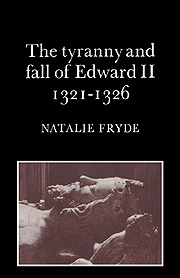Book contents
- Frontmatter
- Contents
- Preface
- Abbreviations
- 1 Problems and sources
- 2 Introduction: The king and the magnates before 1318
- 3 The rise of the Despensers
- 4 The civil war, 1321–2
- 5 The aftermath of the civil war: Imprisonments and executions
- 6 The aftermath of the civil war: Confiscations and the territorial settlement
- 7 Royal finance, 1321–6
- 8 The Despensers' spoils of power, 1321–6
- 9 The defeat in Scotland, 1322–3
- 10 The French war
- 11 The opposition to royal tyranny, 1322–6
- 12 London
- 13 Queen Isabella's invasion and the end of the regime
- 14 Edward II's deposition and ultimate fate
- 15 Epilogue: The regime of Mortimer and Isabella
- Appendix 1 Properties of the Despensers: Main facts and sources
- Appendix 2 The deposition of Edward II
- Notes
- Cited classes of records at the Public Record Office
- Sources
- Bibliography
- Index
5 - The aftermath of the civil war: Imprisonments and executions
Published online by Cambridge University Press: 09 October 2009
- Frontmatter
- Contents
- Preface
- Abbreviations
- 1 Problems and sources
- 2 Introduction: The king and the magnates before 1318
- 3 The rise of the Despensers
- 4 The civil war, 1321–2
- 5 The aftermath of the civil war: Imprisonments and executions
- 6 The aftermath of the civil war: Confiscations and the territorial settlement
- 7 Royal finance, 1321–6
- 8 The Despensers' spoils of power, 1321–6
- 9 The defeat in Scotland, 1322–3
- 10 The French war
- 11 The opposition to royal tyranny, 1322–6
- 12 London
- 13 Queen Isabella's invasion and the end of the regime
- 14 Edward II's deposition and ultimate fate
- 15 Epilogue: The regime of Mortimer and Isabella
- Appendix 1 Properties of the Despensers: Main facts and sources
- Appendix 2 The deposition of Edward II
- Notes
- Cited classes of records at the Public Record Office
- Sources
- Bibliography
- Index
Summary
‘Oh Calamity. To see men lately dressed in purple and fine linen now attired in rags, bound and imprisoned in chains’, wrote the author of Vita Edwardi at the sight of the men imprisoned after Boroughbridge. The Bridlington chronicler greeted the terrible executions which followed the battle with a quotation from the Apocalypse. The series of executions of the king's opponents began a reign of terror in England. It was the first time in a fifteen-year-long rule, dogged hitherto by opposition to the king's favourites and his policies, that Edward had been in such an unchallengeable position.
The execution of Lancaster in its political significance stands apart from the others. For the first time a member of the highest rank of the English aristocracy and of the royal family was executed for his rebellion and treason against the king. Lancaster had been charged with treason before his participation in the battle of Boroughbridge. On 11 March 1322 the king, together with the earls of Kent, Richmond, Pembroke, Arundel and Atholl, had denounced the rebels, in their absence, as traitors. After his capture Lancaster was taken first to York and then to his own castle of Pontefract. On 20 March he appeared before a commission of peers. The Brut chronicler attributed Lancaster's abrupt trial to the Despensers. According to him, it was they who had sought ‘how and in what manner the good earl should be dead without judgement of his peers’.
- Type
- Chapter
- Information
- The Tyranny and Fall of Edward II 1321–1326 , pp. 58 - 68Publisher: Cambridge University PressPrint publication year: 1979
- 1
- Cited by



